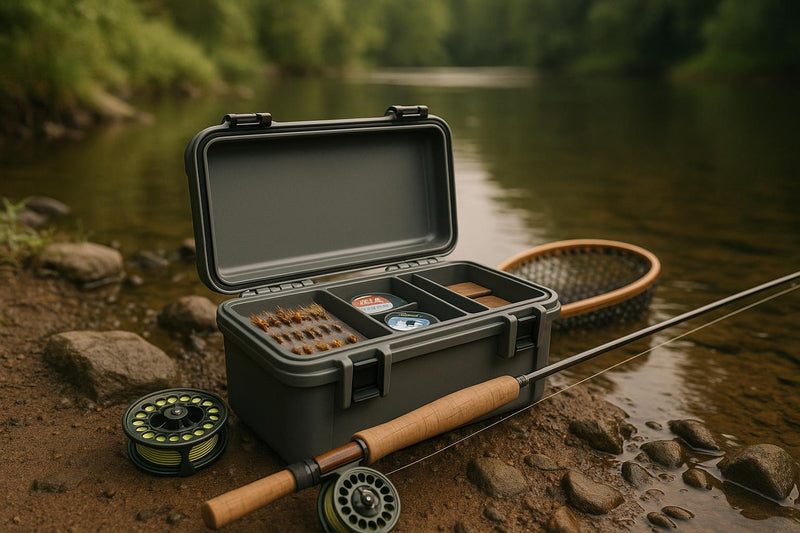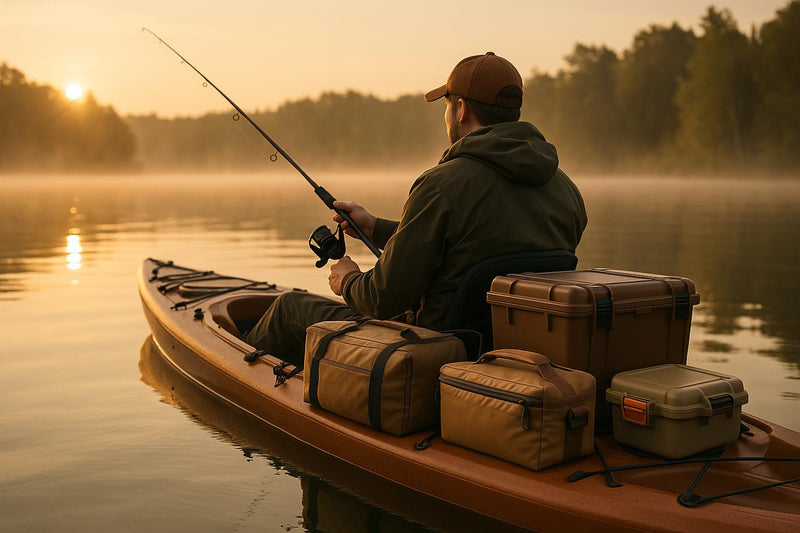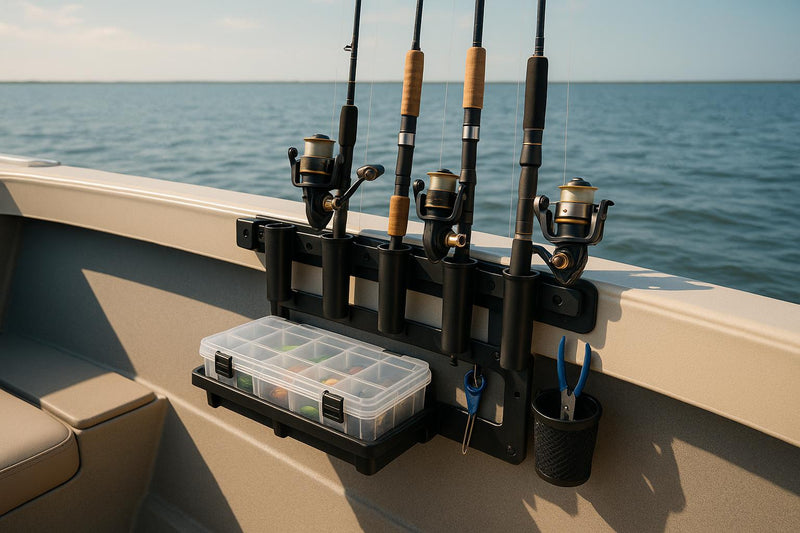4-way stretch fabric is a game-changer for fishing gear. It offers flexibility, water resistance, and durability that outperform cotton and standard polyester/nylon blends. Here's why it stands out:
- Flexibility: Stretches in all directions, making movement easier during activities like casting or reeling.
- Water Resistance: Synthetic fibers repel water, dry quickly, and resist saltwater, UV rays, and chlorine.
- Durability: Withstands repeated stretching without losing shape or strength, ideal for rugged conditions.
- Comfort: Wicks away moisture, keeping you dry and comfortable during long fishing trips.
In comparison, cotton absorbs water, dries slowly, and degrades quickly in wet conditions, while standard polyester/nylon blends lack the stretch needed for full mobility. For anglers, 4-way stretch fabric combines flexibility, water resistance, and long-lasting performance, making it the top choice for fishing apparel.
MEN'S 4-WAY STRETCH BEER CAN ISLAND FISHING SHORT
1. 4-Way Stretch Fabric
Four-way stretch fabric has transformed fishing gear, offering unmatched flexibility and resilience. This fabric is typically crafted with polyester and nylon, materials celebrated for being lightweight, breathable, and excellent at managing moisture.
Water Resistance
Thanks to its synthetic makeup, four-way stretch fabric is impressively water-resistant. Polyester and nylon not only dry quickly but also stand up to saltwater, chlorine, and UV rays. Unlike cotton, which absorbs water and becomes heavy, this fabric stays light even when wet. For anglers facing spray, rain, or the occasional splash, this feature is a game-changer. Beyond repelling water, the fabric’s ability to endure constant exposure to these elements ensures it holds up session after session.
Durability
Durability is another standout feature of four-way stretch fabric. Its polyester and nylon blend is designed to handle the repetitive motions of fishing. Polyester ensures the fabric retains its color and robustness over time, while nylon adds a smooth finish and structural strength. The material’s elasticity allows it to stretch fully and bounce back without losing shape, making it perfect for activities like casting, reeling, or navigating a boat deck. This combination of stretch, strength, and durability ensures long-lasting performance without compromising comfort.
Comfort and Mobility
What truly sets four-way stretch fabric apart is its exceptional flexibility. It allows you to move freely in any direction, whether you’re reaching for your gear, casting a line, or reeling in your catch. Additionally, its moisture-wicking properties work to keep you dry by quickly evaporating sweat. This blend of flexibility and moisture management creates a comfortable experience, helping you stay focused and perform your best during long fishing trips.
Check out our fishing shorts and Mens Fishing Shorts to see how four-way stretch fabric can elevate your fishing game.
2. Cotton
Cotton has been a staple in clothing for centuries, including fishing apparel. But when it comes to performance in marine environments, cotton struggles to keep up. Its challenges with water resistance and durability make it less than ideal for anglers who demand reliability. Comparing cotton to polyester/nylon blends quickly reveals its shortcomings.
Water Resistance
One of cotton’s biggest flaws is its tendency to soak up water. This natural fiber can absorb up to 27 times its weight in water. For anglers, this means cotton will readily take on moisture from rain, sea spray, or even humid air, unlike the synthetic materials used in 4-way stretch fabrics.
Once wet, cotton stays damp for a long time. This leads to a heavy, clingy feel that not only makes it uncomfortable but also increases the risk of losing body heat. Prolonged exposure to cold, wet clothing can even lead to hypothermia during extended fishing trips. Additionally, wet cotton loses much of its UV protection, leaving you more exposed to harmful sun rays.
Durability
Under normal conditions, cotton is durable enough, but in a fishing environment, it’s a different story. Its ability to retain moisture creates a perfect environment for bacteria and microorganisms to grow. Research shows that damp cotton can decompose by 9% in just four days and up to 50% by day six, especially in temperatures above 75°F.
The constant cycle of getting wet and drying out weakens cotton fibers over time. Saltwater, UV rays, and the grime of fishing - like dirt and fish slime - further wear down the material. Cotton also absorbs these substances more readily, making it harder to clean and requiring frequent washes, which only accelerates its breakdown.
Comfort and Mobility
Cotton is often praised for being soft and breathable, offering comfort for casual use. However, these qualities don’t hold up well during active fishing. The fabric lacks stretch, which can restrict your movements when casting, reeling, or navigating a boat. Add in its tendency to retain moisture, and you’re looking at potential chafing and odor issues - problems that synthetic fabrics are designed to avoid.
For anglers who value performance and ease of movement, cotton falls short. Modern synthetic materials, particularly those with quick-dry technology, are better suited to handle the challenges of fishing. If you’re curious about how these materials work, check out this guide on quick-dry fabric technology. For a more comfortable and practical option, consider synthetic fishing shorts like those available here.
3. Standard Polyester/Nylon Blends
Standard polyester/nylon blends strike a balance between comfort and performance, making them a staple in fishing apparel. These synthetic fabrics have been a go-to choice for anglers for decades, offering better performance than cotton while staying budget-friendly. Let’s break down their key characteristics to help you decide if they’re the right fit for your next fishing trip.
Water Resistance
One of the standout features of polyester and nylon is their ability to resist water absorption. Polyester absorbs only 0.4% of its weight in water, while nylon absorbs slightly more at 2.5%. This difference directly impacts drying times - polyester dries much faster, whereas nylon takes a bit longer due to its higher water uptake.
Adding a Durable Water Repellent (DWR) coating can further minimize moisture absorption. However, these coatings tend to wear off over time and need reapplication to maintain their effectiveness.
Durability
The durability of polyester/nylon blends lies in the complementary strengths of these two materials. Nylon stands out for its impressive tensile strength, capable of stretching up to 600% without breaking. This makes it particularly useful for withstanding the physical demands of activities like casting or moving around a boat. Polyester, on the other hand, excels in resisting abrasion, UV light, and chemical damage.
For instance, nylon can lose up to 30% of its strength after 500 hours of UV exposure, while polyester holds up much better in prolonged sunlight.
"Polyester provides superior performance in outdoor settings due to its high UV and water resistance." - Canvas ETC
Together, these materials create a durable fabric that’s well-suited for the rigors of fishing, while also ensuring longevity in outdoor conditions.
Comfort and Mobility
When it comes to comfort, polyester/nylon blends offer a decent experience but fall short compared to modern stretch fabrics. Nylon lends a softer, smoother feel, making it gentle on the skin. Polyester adds durability and helps wick away moisture, keeping you drier during long days on the water. However, without the addition of elastane or spandex, these blends lack the flexibility needed for unrestricted movement, such as when casting or reaching for gear.
"Nylon is softer than polyester but also stronger, while polyester is faster drying, easier to dye and abrasion resistant." - Rajiv Vasudev, Unit Head, Knitting and Processing at RSWM Limited
Breathability is another area where these blends have limitations. While polyester’s hydrophobic properties aid in moisture-wicking, neither material matches the breathability of natural fibers. This can make them less ideal for hot, humid conditions where airflow is crucial for comfort.
Despite these limitations, standard polyester/nylon blends remain a reliable choice for fishing apparel. Plus, advancements in fabric technology continue to improve their performance, as seen in modern options like Reel Comfort's Men's Fishing Shorts.
sbb-itb-cb0a783
Advantages and Drawbacks
When it comes to fishing apparel, the fabric you choose makes a big difference. Each material has its own strengths and limitations, shaping how it performs in terms of comfort, durability, and ease of care out on the water.
4-Way Stretch Fabrics are all about freedom of movement and resilience. Thanks to elastic fibers like elastane and spandex, these fabrics can stretch and recover without damage. However, when polyester forms the base, they can struggle with issues like limited dyeability, susceptibility to melting, and poor moisture absorption. They’re also prone to pilling. While their flexibility is a major plus, they tend to be less stable and durable compared to 2-way stretch options.
Cotton stands out for its breathability and hypoallergenic properties, making it comfortable for all-day wear. But it’s not the best performer when wet. Cotton absorbs moisture, which can weigh you down, and it shrinks after washing. It also has limited stretch and doesn’t hold up as well over time compared to polyester.
Standard Polyester/Nylon Blends strike a good balance between durability and functionality. Polyester offers excellent resistance to abrasions and does a great job wicking moisture. Nylon adds extra resilience and handles repeated stretching better than polyester. Polyester also holds up well against UV rays and moisture, though it doesn’t absorb water effectively, which can be a drawback in certain conditions.
| Fabric Type | Water Resistance | Durability | Flexibility | Breathability |
|---|---|---|---|---|
| 4-Way Stretch | Excellent (with water-resistant finish) | Good (some pilling) | Excellent | Moderate |
| Cotton | Poor (absorbs moisture) | Moderate | Limited | Excellent |
| Polyester/Nylon | Good | Excellent | Limited | Moderate |
This table shows how each fabric performs across key criteria, helping you pick the right material for your fishing needs. For anglers who prioritize mobility during long casting sessions, 4-way stretch fabrics - like those used in Reel Comfort's fishing shorts - offer incredible flexibility. If durability is more important than stretch, a polyester/nylon blend is a reliable choice. Meanwhile, cotton is ideal for dry, shore-based fishing, where breathability is a must.
Take Reel Comfort's Mens Fishing Shorts as an example - they showcase how fabric benefits translate into real-world performance, keeping anglers comfortable and ready for action.
It’s worth noting that washing and prolonged sun exposure can reduce a fabric's UPF rating by causing fading and thinning.
Final Analysis
When it comes to water resistance and durability, 4-way stretch fabric stands out as the top choice for serious anglers. While cotton is known for its breathability and polyester/nylon blends offer basic toughness, 4-way stretch fabric combines flexibility, durability, and comfort in a way that other materials simply can't match.
This fabric holds up remarkably well over time, maintaining its shape and elasticity even after multiple washes. Its stretchability ensures a snug, comfortable fit that adapts to your movements. These qualities make it a go-to material for performance fishing apparel, offering the kind of reliability and mobility anglers need.
For those who prioritize both freedom of movement and long-lasting gear, 4-way stretch fabric delivers on all fronts. Its ability to manage moisture, withstand wear, and provide unmatched flexibility means it performs whether you're battling a trophy catch or enduring a full day on the water.
Take, for example, Reel Comfort's Fishing Shorts. These shorts incorporate 4-way stretch panels and quick-dry technology, giving you the mobility and durability needed for demanding fishing trips. Features like removable thigh pads and reinforced stitching ensure they can handle repeated use while keeping you comfortable.
When you're ready to invest in quality fishing gear, opting for Mens Fishing Shorts made with 4-way stretch fabric is a smart choice. Not only does its durability reduce the need for constant replacements, but it also keeps you comfortable, no matter how long your fishing adventures last.
FAQs
What makes 4-way stretch fabric better for flexibility and movement compared to traditional polyester or nylon blends?
Why 4-Way Stretch Fabric Matters
4-way stretch fabric is a game-changer when it comes to flexibility and comfort. Unlike traditional polyester or nylon blends that stretch in just one direction, this fabric stretches both horizontally and vertically. That means it moves with you, no matter which way you're bending, reaching, or twisting.
For anglers, this flexibility is a big deal. Whether you're casting, reeling, or just moving around the boat, the extra stretch makes every motion smoother and more comfortable. Plus, it’s durable enough to handle long fishing trips, making it a top pick for anyone who values mobility and tough, reliable gear.
Why is 4-way stretch fabric better for fishing in wet conditions than cotton?
When fishing in wet conditions, 4-way stretch fabric is a smart choice. This material is designed to repel water and dry quickly, helping you stay comfortable even on long outings. Plus, its elasticity ensures you can move freely - crucial when you're casting or reeling in a big catch.
On the other hand, cotton isn't as practical. It soaks up water, gets heavy when wet, and takes forever to dry, which can leave you feeling uncomfortable. The durability and quick-drying nature of 4-way stretch fabric make it a dependable option for anglers who need gear that performs well on the water.
Does 4-way stretch fabric stay water-resistant and durable after repeated use and washing?
Yes, 4-way stretch fabric can retain its water resistance and durability over time, especially when treated with a durable water-repellent (DWR) coating. That said, how you care for the fabric plays a big role in keeping these qualities intact. Stick to mild detergents, skip the fabric softeners, and always follow the care instructions provided.
Over time, the water-repellent finish may start to wear off, particularly after heavy use or repeated washing. When that happens, you can reapply a DWR treatment to bring back its water-resistant properties. This small step ensures the fabric stays ready for activities like fishing or any outdoor adventures you have planned.




